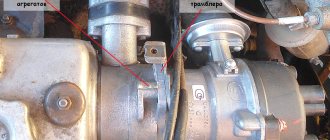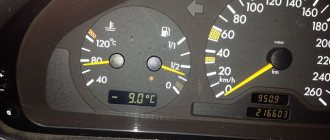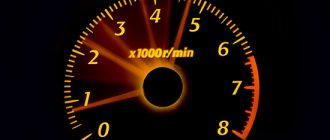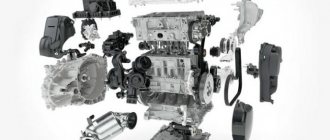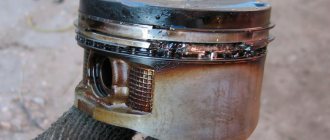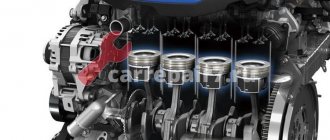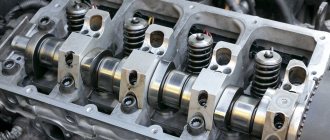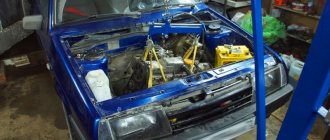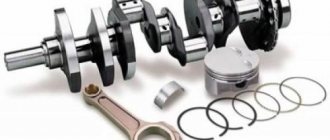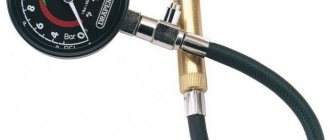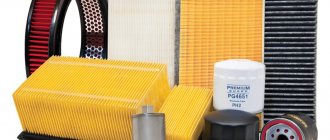string(10) “error stat” string(10) “error stat”
When using a car for a long time, sooner or later the time comes when the driver begins to notice that the car is “pulling” worse and worse. To put it another way, the motor does not cope well even with small loads. To overcome them, you have to spin the crankshaft almost to maximum speed. Other signs also appear: sluggish acceleration from a standstill, difficulties in gaining speed when overtaking, etc. In this case, increased exhaust smoke may be observed, but there are no extraneous noises under the hood when the power plant is operating - it runs smoothly and calmly. So what happened, why doesn’t the car pull?
When the engine doesn't pull well uphill...
Poor quality fuel
In approximately 50% of cases, the “culprit” for loss of traction is fuel. Due to its poor quality or inappropriate octane number (OCN), the engine does not develop power.
You can determine that there is inappropriate fuel in a car tank based on a number of signs:
- The engine started getting worse.
- There was detonation. This symptom manifests itself most clearly if fuel with the required octane number is diluted with gasoline with a lower octane rating.
- When examining spark plugs removed from the cylinder block (BC), you can see black or reddish (brick) carbon deposits, which are uncharacteristic of serviceable parts, which indicates the presence of unnecessary impurities. The first option indicates that gasoline does not burn completely, the second confirms the presence of additives containing metal.
- Ineffective spark plugs. This can be determined during a sharp increase in speed, when the engine has no reserve for further acceleration. The spark plugs may be clogged due to low-quality fuel or may simply have exhausted their service life.
Solving the problem is not difficult: the low-quality fuel should be drained and the tank filled with suitable fuel with the required octane rating. Clean the spark plugs from carbon deposits, and if their service life has come to an end, replace them with new ones, all at once, in a set from one manufacturer. When carbon deposits appear, you will again have to start diagnosing the cylinder-piston group (CPG) and (or) the fuel system.
It is better to refuel at proven gas stations
How to increase throttle response in simple ways
Every experienced motorist knows and uses his own, favorite way to improve the car's former dynamics. Let's look at the most popular ones, but let's not forget that only eliminating the reasons that contributed to the decline in the power characteristics of internal combustion engines will guarantee a return to their former positions.
- Use fuel with a higher octane number (OC). Indeed, the higher the OC, the better the fuel will resist self-ignition during compression. This will directly affect the greater power from the gas explosion.
- Application of "Suprotek". This is a lubricant that is a composition of several components. This is not an additive or additive, but a special composition that interacts with the metal surfaces of internal combustion engine elements. Excellent for removing wear on metal surfaces.
- Replacing a classic air filter with a modernized one. This way you can ensure that a richer mixture is supplied to the engine.
- Changing the exhaust system. Forward flow helps increase power.
- Turbocharged.
- Replacement of worn parts and much more.
In a word, it is necessary and possible to normalize the engine of your car. It is recommended to do this in professional car services, but if the driver has specific knowledge and the required equipment - in his own garage.
Dirty air and fuel filters
If the first of them is clogged and does not allow air to pass through well, the mixture will be excessively rich, that is, it will contain a lot of fuel, which will no longer burn completely. As a result, engine thrust will drop. If the fuel filter is dirty, the result in terms of the operation of the power unit will be the same, with the only difference being that the mixture will become very lean, because there will be little gasoline in it. Contamination of the air filter ahead of schedule can be caused by operating the machine in dusty conditions, and the fuel filter can be caused by low quality fuel.
Fuel filter/air filter
Your car may lose its former agility due to natural problems in the fuel system. For example, due to dirty fuel filters, the fuel supply to the engine may be disrupted. As a result, there will be a shortage of fuel, which will ultimately lead to a change in the behavior of the car.
Also, don’t forget about the air filter, which car enthusiasts often overlook when carrying out routine maintenance. The air filter plays an important role in your car. So, due to contamination of the air filter (attention: this is not a cabin air filter, which cleans the air coming from the street into the car interior), the engine may begin to experience oxygen starvation: the fuel-air mixture will not be enriched with the required amount of oxygen. As a result, fuel ignition will be incorrect, with all the ensuing consequences (loss of power, detonation, uneven engine operation, etc.).
Violation of valve timing
The main parts of the gas distribution mechanism (GRM) are the intake and exhaust valves. They are “obliged” to open and close only at the right moment so that the fuel mixture enters the cylinders on time and exhaust gases are removed. This process is called phase distribution. If it is violated, you will see that the power of the engine has disappeared, which will begin to “triple” and sometimes have difficulty starting.
Causes of valve timing violations:
- wear, as well as incorrect installation, displacement of the chain or timing belt (most often this is a jump by one tooth (link));
- play or deformation of the pulley on the crankshaft;
- wear of hydraulic compensators, camshaft and (or) its bed;
- burnout or rupture of the head gasket;
- Malfunction of the camshaft position sensor (DPRV).
To restore normal operation of the timing belt, it is necessary to set the position of the timing and crankshaft shafts according to the marks. If the chain is worn, replace it. The same applies to the camshaft with a bed, hydraulic compensators, gasket and DPRV.
Exhaust system resistance
Many people consider the only task of the exhaust system to be to muffle loud sounds and remove exhaust gases. However, modern cars are equipped with a catalyst that reduces the level of emissions of harmful substances. If this element is heavily contaminated or destroyed, the passage of gases becomes difficult. As a result, the engine works “as if strangled.”
In Russia, the problem is solved by simply removing the catalyst. However, you need to remember that in some car models such an operation will require changes in electronics (programming).
Removing the catalyst
Violation of ignition timing angles
We are talking about the moment of ignition of the combustible mixture. It is this that is determined by the ignition timing angle (IAF). When it is deviated toward increase, the mixture ignites early, and toward decrease, it ignites late. Both options lead to improper engine operation and incomplete combustion of the mixture, which may be accompanied by popping noises in the muffler. On injection engines VAZ 2110, 211, 212, 214, 215 (there are also classics with an injector, for example, VAZ 2107), the OZ is set automatically, on carburetor VAZ 2101-2106, 07, 08, 09 (the last two models can be with an injector) it must be installed manually.
Signs of violation of OZ:
- difficult engine start;
- increased fuel and oil consumption;
- drop in throttle response and power of the power unit;
- unstable operation of the internal combustion engine at idle;
- The car does not respond well when you press the gas pedal.
Adjusting the OZ on an injection engine
Everything here is controlled by electronics. First you need to make sure that it is functioning properly and that the throttle sensor is working properly. At idle, it should be slightly open by about 1% (if this is not the case, set up a mechanical drive), the normal voltage at its contacts is 0.45-0.55 V (the car’s bot network should produce 13-14.3 V). When you sharply press the gas pedal, the damper should open 90", and the voltage on the sensor should increase to 4.5 V. If this is not the case, you need to adjust the damper drive and check the serviceability of the sensor (TPS).
To do this:
- take the tester and place it in the voltage measurement position;
- disconnect the connector from the sensor - you will see three contacts - one goes to ground, the other to the ECU (which one is connected where, determine from the diagram);
- start the engine and check the supply voltage - it should be approximately 5 V;
- turn off the engine and switch the tester to resistance measurement mode;
- with the damper closed, between ground and the contact going to the computer, the device should show 0.8-1.2 kOhm;
- with the damper open, resistance is 2.3-2.7 kOhm.
If the received data does not correspond to the above parameters, the sensor must be replaced. If this does not work, you should check the ECU.
The main reasons for the reduction in engine power
1. Malfunction of the crankshaft position sensor
There are situations when the DCPV untimely sends a control command to supply the air-fuel mixture. As a result, the power of the power unit drops before our eyes. The main cause of the failure is the shift of the toothed star relative to the pulley and the delamination of the damper. In such a situation, it is necessary to carefully inspect the damper and replace it.
2. Increasing (decreasing) the gap between the spark plug electrodes
During operation, due to strong temperature effects, the distance between the electrodes of the spark plug may decrease or increase. To exclude or confirm your suspicion, you need to check the size of the gaps using a round feeler gauge. If the distance is less or more than acceptable, you need to make an adjustment by bending the side of the electrode or replace the spark plug. As for the optimal spark gap distance, it can be different (depending on the type of spark plug) - 0.7-1.0 mm.
The appearance of carbon deposits on the spark plugs is another clear sign of a problem.
If the engine does not pull well, you need to unscrew all the spark plugs one by one and inspect them. If obvious carbon deposits appear on the electrodes, the device must be cleaned using a brush with metal bristles. It is important not only to clean the spark plugs or replace them, but also to find out the cause of this phenomenon.
Failure of spark plugs
A decrease in engine power may be caused by product failure. In this case, it is necessary to check the performance of the spark plug on a special stand. If the suspicions are confirmed, then the only way out is to replace the set or one spark plug.
There is no gasoline in the tank
You can diagnose the problem using the fuel level indicator. If it is faulty or there is a suspicion that it is “inadequate,” then the presence of fuel can be determined by removing the fuel pump.
Fuel filter contamination, water freezing in the system, pinched fuel wire, fuel pump failure
All these malfunctions can be safely classified into one category, because they all have the same symptoms - the starter cranks the engine, but there is no smell of fuel from the exhaust pipe. If the car has a carburetor, then the reason must be sought in the float chamber. Most likely, fuel is not supplied to it. In the case of an injector, it is easier to check the presence of fuel in the ramp by pressing a special spool (installed at the end of the ramp).
To correct the problem, you need to warm up the engine thoroughly and bleed the power system with a tire pump. After this, all system pipes, hoses and the fuel pump itself are changed.
Fuel pump produces too little pressure
This problem can only be determined by special measurements (taken directly at the outlet of the fuel pump). After this, the quality of operation of the fuel pump filter is checked.
The solution is to clean the fuel pump filter, replace it (if repair is not possible) or install a new fuel pump.
Poor contact quality in the circuit
Poor contact quality in the circuit that powers the fuel pump or failure of its relay. The first thing you need to do to check is to make sure the quality of the “ground” on the car and measure the resistance using a multimeter. If the resistance level is really too high, then the only way out is to clean the contact groups, crimp the terminals well, or install a relay (if the old one is faulty).
9. Failure of injectors or malfunction in the supply system
If there is a suspicion of failure of these elements, it is necessary to check the resistance of the windings using a multimeter for a break or an interturn short circuit. If the cause of the problem is a malfunction of the computer, then such a check can only be carried out at a service station.
There are several ways to eliminate a decrease in engine power for this reason (depending on the depth of the problem) - install a new ECU, clean all injectors, ensure good contact in the electrical circuit, and so on.
DPKV failure
Failure of the crankshaft position sensor or damage to its circuit. In such a situation, the Check Engine light comes on. The first thing to do is to inspect the integrity of the DCP itself, make sure that the gap between the ring gear and the sensor is normal (it should be about one millimeter). The normal resistance of the sensor coil is about 600-700 Ohms.
To solve the problem, it is enough to restore normal contact in the electrical circuit and install a new sensor (if the old one turns out to be faulty).
DTOZH is out of order
The DTOZH - the sensor that controls the temperature of the coolant - has failed. Symptoms of the malfunction are as follows: the engine malfunction lamp comes on. If there is a break, the system’s electric fan begins to rotate continuously. In addition, it is necessary to check the serviceability of the sensor itself.
If engine power has dropped for this reason, then it is necessary to restore the quality of contact in the electrical circuit and install a new sensor.
TPS is out of order
The TPS sensor, which monitors the correct position of the throttle valve (or its chain), has failed. As in previous cases, the “Check engine” lamp comes on here. If there is a break in the TPS circuit, then the engine speed usually does not drop below one and a half thousand revolutions.
The solution to the problem is to clean the throttle assembly and restore the quality of the contact connection throughout the entire electrical circuit. If the sensor is faulty and cannot be repaired, it must be replaced.
DMRV has failed
The mass air flow sensor, the sensor responsible for monitoring mass fuel consumption, has failed. The optimal action here is to check the integrity of the mass air flow sensor or replace it with a working device. If the failure of the mass air flow sensor is confirmed, then it is necessary to make an attempt to clean it, and if repair is impossible, simply replace it.
Knock sensor failure
Damage to the knock sensor. In the event of such a malfunction, the engine malfunction lamp necessarily lights up on the instrument panel. In addition, if the motor fails, there is no detonation in any of the operating modes of the power unit and the engine power also drops. With such a problem, the best option is to restore the integrity of the contact group in the electrical circuit and install a new sensor.
Oxygen sensor failure
The oxygen sensor is broken or its circuit is broken. This malfunction is characterized by the “Check engine” lamp coming on. In this case, the first thing to do is check the heating coil for integrity. Firstly, the resistance is measured, and secondly, the voltage level at the output. The measurement can be made even without breaking the circuit - just pierce the insulation with needles.
To eliminate the malfunction, it is worth repairing the oxygen sensor, restoring the quality of the wiring and cleaning all the holes through which air is sucked in. As a last resort, it is necessary to replace the oxygen sensor itself.
Setting the OZ on carburetor engines
The simplest and most effective way is to use a regular 12-volt light bulb.
Algorithm of actions:
- Rotate the crankshaft pulley until the marks match (on the cover - this is the central mark) using a special spanner. If it is not there, turn on 4th gear and push the car until the marks match.
- From the ignition breaker (distributor), disconnect the thin wire going to the coil and attach a light bulb to it, the second contact of which is connected to ground.
- Loosen the nut securing the distributor (usually it is a “13” wrench).
- Turn on the ignition, make sure that the lamp is on, and slowly turn the distributor around its axis until it goes out.
- Now turn the distributor again until the light flashes, and immediately tighten the distributor fastening nut.
Malfunctioning spark plugs
The planned replacement of these elements of the ignition system is carried out after 20-30 thousand kilometers. If the spark plugs are platinum, the resource increases to 100 thousand km. However, the situation when candles (most often one of them) fail ahead of schedule is not uncommon.
This can be seen and heard by a number of signs:
- the engine starts with difficulty, especially in winter;
- idling is unstable, the tachometer needle jumps, the engine may stop periodically;
- when the power unit is operating, increased vibration is observed, for example, the gearbox shift lever shakes;
- poor acceleration dynamics - the car does not develop full power, it stalls;
- when you press the accelerator, “dips” are noticeable;
- fuel consumption has increased.
When one spark plug does not work, experienced drivers say that the engine is “troubling,” that is, only 3 out of 4 cylinders are working.
To find a faulty part, you need to:
- put on dielectric rubber gloves;
- with the engine running, disconnect the high-voltage wire from each spark plug one by one;
- in this case, the nature of the engine’s operation should change, the speed should drop, but if this does not happen, it means that the cylinder is not working - the spark plug does not produce a spark.
It is worth finding out the reason for the poor performance of the part; it is quite possible that it is defective. If other spark plugs subsequently begin to fail, you will have to look for the cause elsewhere - the CPG or the fuel system.
Causes of malfunction
Fuel injector clogged
It may be clogged with particles in the fuel. Considering the very high accuracy of its dosage, which can be found out more precisely on avtonov.com, the nozzle must be completely controlled. To ensure that the dose is injected into the combustion chamber and does not exceed the norm, the supply tubes are made narrow. As a result, they can easily become clogged if the gasoline contains impurities.
If the injector becomes clogged, the engine's performance will be immediately limited. The car accelerates slowly or lacks power while driving. In addition, the engine idling is uneven, and problems arise when starting it.
Fuel filter
The task of the fuel filter is to clean gasoline/diesel fuel from contaminants. If the filter becomes clogged, this will reduce its throughput, while simultaneously reducing the amount of fuel entering the injectors.
We recommend: 10 ways to mount your phone in a car
As a result, the car has problems with acceleration. The fuel filter is a consumable item that must be replaced periodically.
Flow meter contamination
The purpose of the flow meter is to measure the mass of air that enters the engine intake manifold. Based on this information, the computer selects the right amount of fuel to suck out air and prepare a stoichiometric mixture.
The flow meter sensor may be dirty, causing incorrect data to be sent to the computer. The amount of fuel supplied will be insufficient, which will ultimately cause a loss of engine power. In this case, the Check Engine light may also come on.
Fuel leak
Losses through the fuel line can be significant, as a result of which a sufficient amount of fuel will not be supplied to the injector. This malfunction not only leads to loss of power, but also to dangerous situations.
If you smell gasoline in your car or a puddle constantly forms under the bottom, you need to take it in for diagnostics.
Vacuum leak
Here the situation is similar with a contaminated flow meter, only in the other direction. If additional air is introduced into the system, estimated by the computer, the fuel to air ratio will not be matched.
As a result, the engine does not gain full power during acceleration. Additionally, the Check Engine light may come on.
Catalyst worn out or clogged
A clogged catalyst will lead to poor exhaust flow, which will also affect the amount of fuel allowed into the cylinders. In this case, the engine temperature will be higher, the vehicle will accelerate slowly, and there will be a lack of power.
Unfortunately, problems with the catalyst usually result in expensive repairs. The first thing a mechanic will do is check the fuel system for any problems or leaks. The following are subject to inspection:
- injectors,
- fuel pump and filter,
- air mass meter.
As well as other elements that affect the dynamics of the engine. It may be necessary to perform diagnostics on a regular basis during a test drive.
Compression reduction
Often, the reasons for loss of engine power can be associated with simple wear and tear of the power unit. Do not forget that a car aged about 100 thousand kilometers begins to lose its power by 10-15%. If you think the losses are excessive, you need to check the compression. Its nominal value is indicated in the documentation for the machine. For testing, you will need an inexpensive device - a compression gauge, which is a pressure gauge mounted on a hollow tube or connected to a rubber hose equipped with a tip. It is screwed into the cylinder block instead of a spark plug. Next, disconnect the high-voltage wire from the ignition coil. Crank the crankshaft with the starter and note the highest reading on the compression gauge. The operation should be repeated for each cylinder.
Compression check
Pressure below that specified in the instructions by more than 15% indicates wear of the rings, pistons, cylinder block walls, and valves. To solve the problem, you can bore the BC to the repair size, replace the piston rings, grind (or replace) the valves.
Automatic transmission malfunctions
One of the tasks of the gearbox is to transmit torque to the wheels. And if this process is disrupted, then the engine does not gain momentum. You step on the gas and the acceleration is sluggish. The whole point may be a slipping automatic transmission.
There are several reasons for this:
- low-quality gear oil or not what the manufacturer recommends;
- clogged filters;
- clogged valve body channels;
- faulty solenoids (in this case, slipping is observed “hot”);
- wear of friction clutches (maximum service life 200-300 thousand km);
- problem with the control unit.
Most of the above faults are difficult to eliminate in a garage. Therefore, you will have to use the services of a specialized technical station.
If the carburetor engine does not pull
A carburetor is a mechanical device for preparing a combustible mixture of fuel and air. If the proportions of the components in this mechanism are violated, then the engine does not pull.
You need to adjust the carburetor in stages:
- Jets. Check their calibration - the part supplying air must have a larger diameter than the one through which fuel is supplied.
- Throttle valve. When you press the gas, it should open completely (if this is not the case, adjust the drive).
- Ignition system. Its contact version was discussed above. To check the contactless system, turn on the ignition and look at the dashboard voltmeter - its needle will approach “12”, and after a second it will rise higher. If there is no voltmeter, install a known-good switch and check the operation of the ignition system again.
Standard carburetor
Reasons for the decline in dynamics
Experts believe that the main reasons for the decline in dynamics are:
- Pouring low-quality fuel into the fuel tank. So, if a decrease in throttle response was noticed immediately after visiting a gas station, the reason is clearly proven. The only way to correct this situation is to completely replace gasoline or diesel fuel. Otherwise, even the possibility of damage to the power plant cannot be ruled out.
- Air filter clogged. If it becomes clogged with dirt, the air-fuel mixture does not enter the engine correctly, and this directly affects the efficiency of the engine.
- Fuel filter clogged. The fuel no longer undergoes proper control; a large amount of debris gets into the tank, which also directly affects the performance of the power unit.
Replacing the fuel filter is one of the simplest car maintenance procedures.
- Used or low-quality spark plugs. If dirt is clogged in the SZ electrodes, the spark plugs are worn out, or the gap of the contact group is shifted, the efficiency of fuel combustion decreases and the dynamics of the internal combustion engine decreases. The problem is eliminated by simply replacing the SZ.
- Mechanical damage to the power plant. In this case, the efficiency of the internal combustion engine decreases due to a drop in compression or excessive wear of the piston rings. This is also facilitated by an increase in the gaps in the engine valves. Experts call the first sign of such problems the appearance of extraneous, uncharacteristic noise in the engine, which appeared unexpectedly.
- A clogged catalyst also affects the loss of engine dynamics. Replacement solves all problems.
Gasoline units
As a rule, the reasons for the drop in throttle response on gasoline and diesel internal combustion engines are the same, but there is still a difference. The power of a gasoline power plant implies a relationship with crankshaft speed. Unlike diesel units, the power characteristics of gasoline internal combustion engines directly depend on the speed described above. The higher they are, the more dynamics the engine produces. And if an engine powered by gasoline fuel is, for whatever reason, unable to produce maximum speed, its dynamics drop accordingly.
We recommend: Why doesn't the engine pull? Reasons for power loss
The crankshaft rotation speed decreases for one simple reason: due to overheating of the internal combustion engine. This often happens during the hot season or when driving for a long time in a traffic jam. Obviously, allowing the internal combustion engine to overheat is extremely undesirable.
Some foreign cars are simply not designed for our climate
There are other reasons for the decline in the dynamics of gasoline internal combustion engines. For example, an incorrectly adjusted accelerator pedal. An elementary reason, but one that can significantly affect the efficiency of the internal combustion engine.
Diesel engines
Recently, there have been frequent problems with Japanese diesel power plants. It is interesting that after the 100 km/h line the engine does not show any problems, but before that it behaves extremely poorly: it does not pull uphill, starts poorly, etc.
The main reason for the decrease in throttle response of a diesel internal combustion engine is the limitation of fuel supply. Most experts agree with this opinion. And indeed, this happens in 80 out of 100 cases. The remaining secondary problems are related to difficulties with air leaks, a frozen fuel pipe (a common problem for Russian drivers), etc.
The next popular reason is related to wear of the injectors. For example, if a second-hand car has been plowed, its injectors will definitely wear out. As a result, the car will smoke a little. This can be repaired, but most drivers sell such equipment, but first use a trick to eliminate the smoke and sell the Pepelats at a higher price.
Black smoke from a diesel engine is not always as dangerous as from a gasoline engine.
The trick sometimes involves adjusting the fuel supply, a kind of “crushing” of power. The original XX speed is restored, the car no longer smokes, but also does not pull. Checking the “dark horse” is quite simple: you need to return the idle speed to its previous position, if smoke appears, then the injectors need to be repaired.
Another reason for the reduction in the power characteristics of a diesel internal combustion engine is the jamming of the distributor timer piston in the injection pump (high pressure fuel pump). This is especially clearly indicated by the loss of dynamics at high speeds.
It is also noteworthy that a change in exhaust smoke does not always indicate a problem with the dynamics of cars with a diesel engine. Any such car, if you fully press the accelerator pedal or suddenly start from a stop, will start smoking black.
We recommend: Volvo FE truck: model review, features, specifications
On turbocharged internal combustion engines, the cause of a drop in power is most often a bad turbine. It is diagnosed by removing the rubber tube from the injection pump. Then the corresponding measurements are taken with a pressure gauge. At speeds up to 4500 per minute, if the turbine is working properly, the readings should indicate at least 0.5 kg/cm2.
The difference in the reasons for the drop in dynamics may also be due to the difference between an injection and carburetor engine. The table below shows the most common situations in which power does not develop on an injector and carburetor internal combustion engine.
Table: why the power characteristics of the engine dropped (injector and carburetor)
| Injection internal combustion engine | Carburetor internal combustion engine |
| Dirty fuel or air filters | Inadequate opening of carburetor valves |
| Fuel pump filter screen is dirty | Dirt accumulation in the carburetor and clogged fuel pump fittings |
| Incorrect operation of the vehicle ECU | Pressure drop or malfunction in the needle valve |
| Dirt accumulation in injectors | Problems with the float element |
| Malfunctions of the fuel pressure regulator, main sensors whose operation is related to the engine and damage to the lambda probe | Reduced nozzle capacity |
| — | Faulty economizer valve |
Why does an injection engine lose power?
The peculiarity of this engine is a fuel pump that works like an electric motor. If it does not work correctly, the engine speed will be unstable in all ranges. That is, fuel will be supplied unevenly, which will lead to a drop in the power of the power unit. The pump may not work well due to a dirty filter - it needs to be checked and cleaned if necessary. Another reason for the loss of power in an injection engine is the inefficient operation of the injectors, which become dirty during operation. You need to carry out diagnostics using a special (or even homemade) stand and clean the parts or replace them with new ones. The next reason is the incorrect operation of the electronics. These could be sensors or the ECU itself. In the latter case, it is recommended to install a working unit or go to a service station.
If you have any questions, leave them in the comments below the article. We or our visitors will be happy to answer them
The engine does not develop power, causes and solutions
The engine does not develop full power for various reasons. There is a common saying among electricians about this. When a car enthusiast, when visiting a car service center, complains about poor power delivery, the engine response when pressing the accelerator pedal, the car does not move, does not pull, you can often hear the answer on what to do from an electrician diagnostician: “coil, spark plugs, wires.” In other words, the reason why the engine does not develop power lies in the ignition system. And, indeed, this is the most common reason. Replace these parts and fix it. But, this is not always the case. There are other reasons too. Let's go from complex to simple.
Low compression causes power loss
Compression rings in the engine are responsible for the amount of pneumatic tightness in the cylinders. The lower the compression ratio from the factory parameters, the worse the combustion processes will occur. And since not all the fuel is burned, the engine does not develop full power. A drop in compression may be due to:
- Coking of rings.
- Broken compression ring.
- Cracked or broken piston partition.
- Wear of the liner when the gap between the ring and the liner increases.
- Valve burnout or loose fit, resulting from carbon deposits.
Uneven compression also leads to loss of engine power and premature wear.
How to increase compression and restore former traction. It is worth noting that uneven or low performance is not a reason to decide on global repairs. Now let's go from simple to complex. The most common reason is coking of the rings, their occurrence. Important note: when the rings fit into the groove, the heat removal stops and the piston ends up in a heat bag, which increases wear significantly. This is what the piston will look like when exposed to heat.
Photo source: Service-S-Auto
This is why the mobility of compression rings is so important. A simple and correct solution is to use an engine flush, Rvs Master MF5.
It is capable of decoking the rings and clearing carbon deposits from the groove, without harming the rest of the engine components. As a result, the rings will become mobile and the power will return to its parameters.
It is possible to compensate for liner wear with a repair and restoration composition for the engine. It forms a metal-ceramic protective layer, which is capable of filling scuffs and growing a new layer up to 0.5-07 mm. The result of the formation of a metal-ceramic layer is the optimization of gaps, and as a result, the growth and equalization of compression. The product line includes repair compounds for gasoline, diesel and two-stroke engines.
The use of an engine reducer allows you to increase power by 3 hp. Real indicators of increase on the power stand from racer Sergei Makarov.
Burnouts and breakdowns will have to be treated “surgically”, only by replacing parts.
Injector nozzles and fuel pump
The next common reason why an engine does not develop power is the fuel-air mixture.
Almost any driver can check the condition of the air filter and replace it. The main thing is not to wash it under water, there are such cases. If the formation of the fuel-air mixture does not occur in the required proportions, then you should not expect traction.
When the fuel pump goes out, that is, the pressure decreases, you will subjectively feel like someone is holding the car by the “tail”. The presence of water in the tank can also cause a decrease in power. Don't forget about the presence of a fuel filter and mesh. Modern cars are equipped with fuel filters and a pump. Therefore, the pump died - we change it along with the filter and mesh. In general, pumps last a long time, the main thing is not to ride on an empty or almost empty tank, since the pump is cooled by fuel. And its absence or a small amount leads to rapid wear, a drop in pressure and power.
Underfilling or overfilling a fuel injector can cause a lot of trouble. We are more interested in underfilling. Resin and carbon deposits on the injectors cause the engine to not develop power. An important parameter is the spray pattern. If it is modified, then fuel combustion will occur behind the front, which will lead to accelerated wear of the engine. Overfilling fuel leads to failure of the catalyst, aging of the oil, and washing off of the oil film from the cylinders. That is why official dealers pay increased attention to the fuel system and suggest flushing the injector every 20-30 thousand km. In advanced cases, you will be offered ultrasonic cleaning of injectors. All these measures are costly, both financially and physically. You have to sign up for the service, wait in line, and pay a lot of money. You can clean the injectors from carbon deposits yourself using the injector cleaner Rvs Master IC
The additive for cleaning IC injector nozzles does not change the chemical composition of gasoline, does not lift dirt from the tank and does not clog the injector filter. Thanks to the active substance, serpentinite and catalysts, it carefully cleans the injectors of tar and carbon deposits, improves the pressure in the system, and restores the spray pattern. As a result, engine power returns to normal. In addition, it cleans the valves and lubricates the upper compression ring. Based on its functions and properties, it is the best injector cleaning additive on the market.
For flushing and cleaning diesel injectors, the DP3 Rvs Master option is offered.
Diesel injector cleaning additive DP3 is suitable for all types. It also restores plunger pairs and injection pumps and improves starting.
Afterburning catalyst
We said above that overfilling fuel injectors can lead to failure of the catalyst. This also leads to driving without warming up the engine. In this case, when the engine has not warmed up, especially in winter, the fuel-air mixture does not burn completely and enters the catalyst, where it successfully destroys it. “It’s like driving a car with a trailer” - is this a familiar situation? This happens when the catalyst sinteres and does not allow exhaust gases to pass into the muffler. Back pressure is created and the engine does not develop power. In this case, only removing the catalyst and replacing it with a flame arrester will help.
To avoid this condition, it is enough to use a FuelXx fuel combustion catalyst. The catalyst is available for gasoline and diesel engines. The fuel additive optimizes combustion processes, which allows the fuel to burn in the combustion chamber rather than go into the oil and exhaust tract. In addition, the upper compression ring decarbonizes. Reduces carbon formation. A clean engine is the key to a long service life.
Transmission faults
Transmission malfunctions, strictly speaking, cannot be considered as a loss of engine power. This is rather a subjective perception. When the clutch slips or the automatic transmission torque converter is faulty. In such cases, the power unit develops speed, but the car has difficulty moving. Here's another example: soured drum or parking brake pads. You step on the gas, but they stick and don’t allow you to accelerate.
In custody. Each cause of power loss requires careful consideration and diagnosis. In one case you can fix it yourself, in another only by contacting a workshop.
